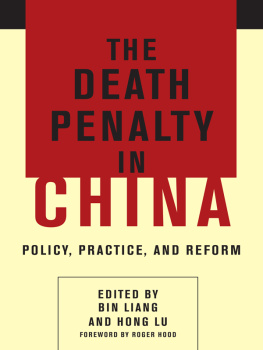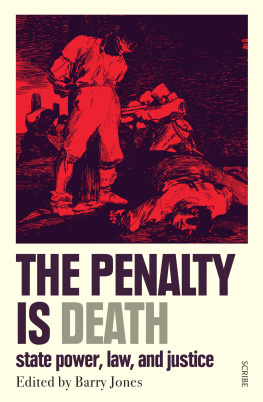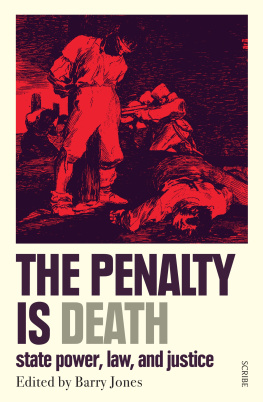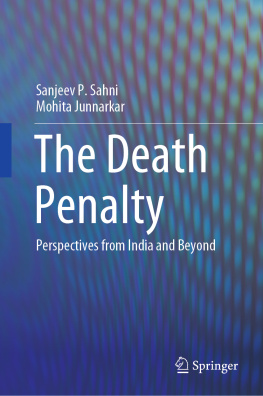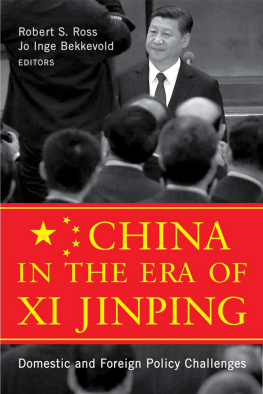THE DEATH PENALTY IN CHINA
The Death Penalty in China POLICY, PRACTICE, AND REFORM Bin Liang and Hong Lu EDITORS Roger Hood FOREWORD |
| COLUMBIA UNIVERSITY PRESS NEW YORK |
COLUMBIA UNIVERSITY PRESS
Publishers Since 1893
New York Chichester, West Sussex
cup.columbia.edu
Copyright 2016 Columbia University Press
All rights reserved
E-ISBN 978-0-231-54081-0
Library of Congress Cataloging-in-Publication Data
Death penalty in China (Liang and Lu)
The death penalty in China : policy, practice, and reform / edited by Bin Liang and Hong Lu ; foreword by Roger Hood.
pages cm
Includes bibliographical references and index.
ISBN 978-0-231-17006-2 (cloth : alk. paper) ISBN 978-0-231-17007-9 (pbk. : alk. paper) ISBN 978-0-231-54081-0 (ebook)
1. Capital punishmentChina. 2. Criminal justice, Administration ofChina. I. Liang, Bin, 1972- II. Lu, Hong, 1966- III. Title.
HV8699.C6D434 2016
364.660951dc23
2015020786
A Columbia University Press E-book.
CUP would be pleased to hear about your reading experience with this e-book at .
Cover design: Jordan Wannemacher
References to websites (URLs) were accurate at the time of writing.
Neither the author nor Columbia University Press is responsible for URLs that may have expired or changed since the manuscript was prepared.
CONTENTS
by Roger Hood
Bin Liang
Hong Lu, Yudu Li, and Charlotte Hu
Ning Zhang
Yunhai Wang
Susan Trevaskes
Zhigang Yu (translated by Charlotte Hu)
Xingliang Chen (translated by Charlotte Hu)
Moulin Xiong
Shanhe Jiang
Hualing Fu
David T. Johnson and Michelle Miao
Bin Liang and Hong Lu

ROGER HOOD
AT THE TURN OF THE TWENTY-FIRST CENTURY, I was fortunate to be invited to China with my colleagues, Saul Lehrfreund and Peter Hodgkinson, under the auspices of the United Kingdom Foreign and Commonwealth Office, by the Ministry of Foreign Affairs of the Peoples Republic of China. The purpose, from the Chinese side, was to inform us about the justifications for the use of the death penalty in the context of Chinas social, cultural, and political development. From our side, we hoped to make our hosts more aware of the international movement to abolish the death penalty as a violation of the right not to be arbitrarily deprived of life or to be subject to cruel, inhuman, and degrading treatment or punishment, as established in Articles 6 and 7 of the International Covenant on Civil and Political Rights (ICCPR), which China had signed in 1998. We stressed that until the death penalty was abolished, China should move to restrict the scope of capital punishment to only the most serious crimes with lethal or other extremely grave consequences and to enforce the safeguards established by the United Nations to protect the rights of those facing the death penalty, particularly to receive a fair trial and to be presumed innocent until proved guilty by a competent, independent, and impartial tribunal.
We were received with courtesy, but the responses to our message were rigidly defensive. We were reminded how long it had taken the United Kingdom to abolish capital punishment since the issue had been raised early in the nineteenth century, and it was suggested by some that it would also take a century before full abolition would become possible in China. The developing international engagement, marked by European UnionChina human rights dialogues and seminars, appeared to be having little impact. Indeed, I recall that during the European UnionChina Human Rights Seminar to discuss the death penalty that was held in Beijing in May 2001, a major strike-hard (yanda) campaign was simultaneously being put into effect, resulting in at least 1,781 executions between April and July.
Yet changes were afoot, led by Chinese academic lawyers. At a conference held at Renmin University in 2005, the agenda was no longer Should China abolish the death penalty? but rather How can China move forward to abolish the death penalty?
Things have changed remarkably since then. The criminal policy of blending leniency and severity to maintain social fairness and justice has been firmly established. This has meant that the number of capital crimes has been reducedfirst from 68 to 55 and then hopefully to 46 (proposed in the Ninth Amendment to the Criminal Law in November 2014, which is currently under review)and China officially confirmed before the United Nations Human Rights Council in 2007 that its final goal is abolition. Several procedural safeguards have been introduced in the hope that they will improve the prospects of a fair trial, curb abuse of state power, and avoid wrongful convictions of the innocent arising from coerced confessions. A system of reviewing all immediate death sentences by the Supreme Peoples Court was reestablished in 2007, resulting in the introduction of guidelines to distinguish cases where the courts regard immediate execution as necessary from those for which the death penalty can be suspended; to try to remedy arbitrariness of decisions made by different courts; and to ensure that executions are limited to the gravest cases. Although statistics of the number of death sentences and executions remain, most regrettably, a state secret, there appears to be no dispute among Chinas academic community or foreign-based nongovernmental organizations that the number of executions has declined very substantially, even though it is still estimated that about 3,000 convicted citizens are executed annually. There is still a long way to go, but China is undoubtedly making strides along the road to abolition.
Thus the time is right for an assessment of what has been achieved and what barriers remain to limiting further the scope of capital offenses with the eventual goal of abolition. Hence, this excellent collection of essays should be greatly welcomed because it provides insights into the way in which Chinese scholars, both within and outside China, as well as foreign scholars who have studied the Chinese system in depth, explain the changes under way and assess their significance. It has been edited with great skill by Professors Bin Liang and Hong Lu, both natives of China now teaching and researching in the United States. Through their extensive contacts, they have been able to obtain contributions from the new generation of Chinese scholars, few of whom are well known in the West. Their reflections on the historical, legal, political, and cultural context within which death penalty reform in China is being pursued provide an authentic and fresh picture of how the debate on abolition is being pursued in that vast country. Particular significance is given to two factors. First, the historical legacy of using the death penalty as an instrument of political power and as a means of legitimating the states claim to provide security is analyzed. Second, the role of public opinionor, more accurately, public pressure, especially from the families of victimsis acknowledged as a restraining element on a judiciary that is still far from being politically independent.

